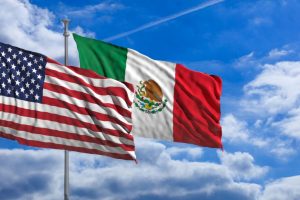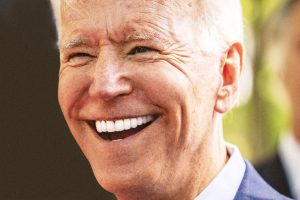After the fiasco of the last presidential election, when a few hours before the polls closed, the “experts” took Hillary Clinton’s victory as fact, who dares to guess the future?
Of course, many. In the post-truth universe where perceptions outweigh facts, the story that Mr. Trump “has a double-digit disadvantage” in most polls seems appealing. “If the election were today, I could lose even in Texas and Florida.”
The White House tenant’s rosary of nonsense lies and thunderous stumbling blocks feed the hope that the end of a historical period marked by selfishness and hatred is very near.
As if everything was so easy …
Light versus Dark; Order vs Chaos
“This will be the most important election ever” (until the next election arrives).
In addition to the torrent of rhetoric that, like every 4 years, will flood the country in the next three months, the real dispute between the teams of Donald Trump and Joe Biden will be to impose a narrative that manages to channel the emotions of the more than 100 million of citizens who, by Tuesday, November 3, will have to decide who will dispatch from the White House as of the third Monday in January 2021.
That’s what the national conventions of the Democratic and Republican parties are for. To try to win the battle for “the air” of public opinion. And certainly, both Joe Biden and Donald Trump himself and their respective choirs did an exceptional job in trying to define the terms of the electoral contest in a sufficiently clear way a nation of 320 million people trapped in one of the deepest crises in their short years. more than 250 years of history.
In real life, both conventions were television productions to strengthen the spirits of the electoral bases of both candidates. With supposed headquarters in Milwaukee, Wisconsin, the Democratic Convention was a virtual event that had a slightly larger audience than the Republican Convention that – as should be expected of a person like Trump – used the White House itself, in Washington DC, as a mere show background.
In his main message, the former number 2 of Obama, highlighted the catastrophic work of the Trump Administration in responding to the pandemic, repudiating its racist, isolationist rudeness and manipulation of the worst social sentiments. Much like Star Wars, he defined this choice as the great battle between “light”, which he represents, and “darkness” which, of course, is embodied in the character with the shiny toupee.
A week later, in a better-produced television show, the president tried to portray his opponent as some kind of puppet, of the “radical left” and / or the imperial interests of evil China. In his promotional spots, he uses the visit he made, “to thank”, the Mexican president.
By tradition, conventions mark the start of the final stretch of the electoral contest. But as Barack Obama himself pointed out in his turn before the cameras, this time the vast majority of those who are going to vote have already made their decision. The extreme polarization and politicization of large spaces of public life leaves little room for great surprises on the part of the electorate.
Above all, because as in every midterm election, the essence of the campaign will be that of a referendum on the incumbent president. “Trump yes or Trump no”, that will be the central question. Which, up to now, Biden, an excellent representative of the American political establishment, seems to have understood very well.
The 435 elections to renew the House of Representatives, part of the Senate, and a large number of positions and local referendums, usually follow the inertia of the presidential election.
The battle for the “ground”
To suppose that American democracy is reduced to what Charles Lewis said a generation ago in his book “The Buying of the President” is an understatement. And the thesis that competition to raise and spend billions of dollars plays a central role in the dispute for political power is not false.
Thanks in large part to the Trump phenomenon, the idealized vision of American democracy today convinces few in the world. The United States has been revealed as an oligarchic system in which the dispute for political power is subject to the great economic interests, for which it is perfectly possible that “whoever obtains 3 million votes above his opponent does not necessarily win the elections. ”(In the words of Hillary Clinton).
Along with a kind of auction, campaigns are the cyclical opportunity to design and weave large networks of interest around agendas of almost any kind. Generational, demographic, subject, cultural, and so on.
Simplifying to the extreme, it is possible to see behind each candidacy a careful tangle of alliances between political groups and different social agendas trying to build majorities, which is particularly important in a handful of states where the balance of power is not clearly determined, which are those that finally determine the electoral result.
At 77, 47 as a legislator, Biden represents, first of all, the old Democratic establishment. What remains of unionism, the formal representation structure for African Americans and Latinos. It appeals to the digital segment of the economy, as well as some industries that bet on globalization, many of which were consolidated during the Clinton and Obama administrations. Also, thanks to its alliance with Bernie Sanders, it wants to have broad segments of young people, feminist organizations, who most strongly promote green and progressive agendas.
At 74, almost all a billionaire and celebrity star, Trump represent, first of all, himself. It boasts the support of large American industries and a good part of large financial capital. Also to an important segment of the white evangelical electorate, especially those over 60 years of age (traditionally the most important at the polls). It has, of course, the open support of the extreme right, the NRA, and a significant segment of the low-income white electorate, especially those who blame “immigration” for all its ills.
In terms of the map, it is very clear that in the most prosperous states with high demographic concentration, the majority of the votes tend to be for the blue candidates. On the other hand, in the states with more poverty, physical isolation, and less education, it is the Reds who usually prevail.
All this, within a political system and social dynamics explicitly designed around the idea of 50/50, has led, long before the emergence of Mr. Trump, to a growing polarization that has returned to Washington, the capital, his natural condition of swampy and sterile territory, at least as far as political consensus is concerned.
Depending on the central narrative that is imposed, the views of the citizen before the electoral ballot should be quite clear.
Although Trump’s electoral strategy proved its efficiency in 2016: it capitalized on the distrust and disenchantment of broad social groups in the face of “the traditional political class”, it also knew how to take advantage of the frustration and bitterness caused in an aging middle class by the great financial crisis of the 2008-09 and, above all, he dared to encourage the darkest feelings (hatred and racism) of the extreme right, the current context could hardly be more adverse.
Isolationism and walls failed. The fact that the United States is the country in the world with the most deaths from COVID-19 is probably the clearest evidence of the great limitations of Mr. Trump’s type of histrionic leadership. That unemployment and economic paralysis are the highest in decades also overshadow any progress registered in financial speculation.
The real survey
Perhaps as a natural part of democracy as a spectacle, they make sense –the uncertainty as an incentive for citizen participation–, although it is very clear what national polls serve at this moment of the contest: for nothing. There is a long way from the use of surveys as electoral propaganda to their use as work tools.
Furthermore, considering that the polling business is based on the premise that around 50 percent of citizens will not vote, it would be enough with a series of small anomalous behaviors of some citizen groups to alter any electoral forecast.
Beyond the entanglement caused by the constant attacks of Trump and his against the vote by mail and the little veiled threats of the president that, if he lost at the polls, he would refuse to leave the White House, the election system Indirect requires a state-by-state weighting in the elaboration of any possible scenario for the night of Tuesday, November 3.
Let’s look at three possible scenarios:
One:

Biden wins. This exercise is the one that most coincides with the surveys at the end of August.
Florida, Michigan, Minnesota, Nevada, and Pennsylvania are opting for the working-class candidate. Biden the empath is a better choice than Trump the egomaniac.
North Carolina, Ohio, and Texas end up being defined by Trump.
Reasons: His social media platforms are not enough for the president, from which he proclaims his contempt for the mainstream media and practically all those who are not his worshipers. Biden prevails in states where respect for diversity, immigration, and workers have a particularly important weight among the electorate.
Two:

Trump wins. The scenario of 4 years ago is repeated. In most mid-term elections, citizens make their own that of “better bad for known than good for knowing.”
By endorsing his triumph in Florida and Ohio, he surpasses the candidate of the radical left. He could even lose Michigan and Pennsylvania and still get the 270 votes he needs in the Electoral College.
Reasons: The engineering of segmented ads in social networks (complicity of Facebook according to its critics), its undeniable superiority to mark the media agenda and its wide advantage in the entertainment world, help it to continue building its “great and beautiful” border wall.
3.-

Biden wins. Of dispels the mirage.
The rustbelt awakens., Michigan, Minnesota, Wisconsin, and Ohio, states that represent an era in which the great industry of the United States was the best in the world and its workers had a guaranteed route to achieve their American dream (during childhood and youth of both candidates), they decide to support the candidate who offers them a return to the time of “Made in the USA”, as a supreme economic value.
The bible-belt, including Florida and North Carolina, can stay with Trump and the result remains the same.
Reasons: In addition to the boredom and disillusionment with the poor and frivolous leadership shown in the face of Covid-19 and the collapse of the economy, the anti-Mexico rhetoric does not reach Trump. Not only its border wall – of which only 5 miles out of 2,000 are new – but the simple change of name to the “infamous” NAFTA, are seen as such by voters, but the same dynamic of seeing in each person from brown skin to a terrorist or rapist, ends up wearing out.
Of course, the possible scenarios are many. Only those who pull the strings of the campaigns know how much and how they will spend in each hinge state. It does not seem risky to assume that Trump will sweep the debates. In any case, at the moment the only thing clear is that nothing is insured.










